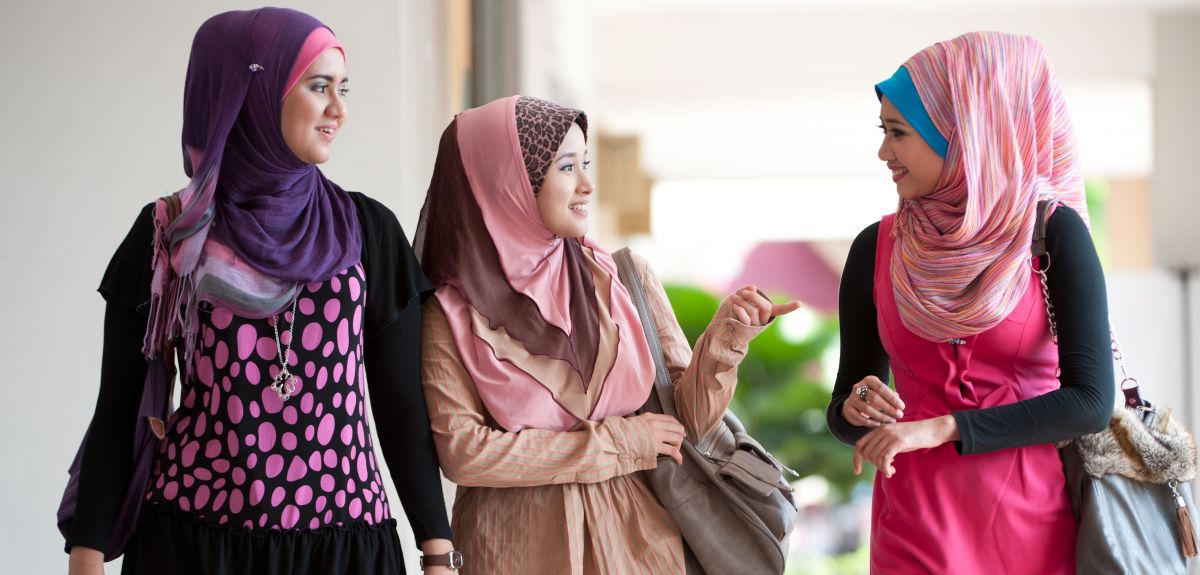
Credit: Shutterstock images
The veil worn by Muslim women 'may signal that they ARE integrating more'
Researchers have studied why young, highly educated Muslim women who live in modern urban environments may be choosing to wear the veil and have uncovered a paradox.
Their study, which drew on data of thousands of women living in Belgium, Turkey and 25 Muslim countries, suggests that women who cover their head this way are often doing so because they are engaging with a modern, secular world. It says that in social situations in which they mix with non-Muslim friends, work outside the home or and interact with strangers, they may wear the veil as a signal to others in their community to show that mixing with others does not compromise their religious piety. It may also be used to strengthen their own sense of commitment to their faith and its values in a secular world, says the paper.
The study published in the journal, European Sociological Review, is thought to be the first empirical study into why wearing the veil should increase in line with modernisation. The researchers from the University of Oxford and the European University Institute tested earlier mathematical models to see how the intensity of wearing the veil varied according to the women’s education, employment, urbanisation and contact with non-Muslims. The study includes the wearing of headscarves, the turban or hijab, the chador, the burqa (which covers the face too), and no head covering at all.
Through statistical modelling, researchers find that as you might expect the tendency for veil wearing decreases among young, highly educated women when they are exposed to modern influences if they are 'averagely religious' Muslim women. However, Muslim women who are 'highly religious' tend to increase their wearing of religious head coverings and use more conservative styles as the level of modernisation, or 'risks' they are exposed to, increase.
In Turkey, highly educated Muslim women who were highly religious tended to cover their head more than other highly religious Muslim women. In Belgium, highly religious Muslim women who socialised with non-Muslims used the veil more than highly religious Muslim women who did not mix as much with the native population. In Muslim countries where great store is placed on the piety of future brides, highly religious single women who are likely to be on the marriage market or who are highly educated tended to wear the veil more than otherwise very similar but married women and those who did not leave the home as much, says the study.
To measure levels of religiosity, the women were asked how often they prayed, read the Quran, visited the Mosque or fasted, and where asked about how important their Muslim faith was to their lives. The study includes religious women who wear the veil because of personal choice and those who are doing it to fulfil their families’ wishes.
The study points out that the massive inflow of Muslim immigrants to Western countries and the rise of violent Islamist groups have made Muslim minorities a target of hostility and discrimination, with veiling visually symbolising these tensions. It concludes that such policy decisions might be counterproductive by depriving Muslim women from integrating. It suggests that if they cannot signal their piety through wearing the veil they might be forced to stay at home.
Veiling could be a sign of more rather than less integration. Highly religious women who have more native friends and live in areas dominated by areas use the veil to keep their pious reputation
Professor Diego Gambetta, Official Fellow of Nuffield College, Oxford
Study author Dr Ozan Aksoy from the Department of Sociology at the University of Oxford, comments: 'There are important implications for policymakers as if the option of wearing a veil is taken away from Muslim women, they fall on costlier ways of proving their piety. A veil is seen as a genuine expression of a woman’s religiosity. Paradoxically, it is the women who are engaging with the modern world who appear to rely on the veil to signal to others that they will not succumb to the temptations of modern urban life.'
Study co-author Professor Diego Gambetta, Official Fellow of Nuffield College, Oxford, and Professor of Social Theory at the European University Institute, adds: 'Contrary to the populist cant that seems now dominant in Europe, veiling could be a sign of more rather than less integration. Highly religious women who have more native friends and live in areas dominated by natives use the veil to keep their pious reputation while being integrated. Banning or shunning veiling would deprive them of a means that allow them more opportunity for integration rather than marking their differences.'
The paper, Behind the Veil: The Strategic Use of Religious Garb, was published in the European Sociological Review
 New study estimates NHS England spends 3% of its primary and secondary care budget on the health impacts of temperature
New study estimates NHS England spends 3% of its primary and secondary care budget on the health impacts of temperature
 International collaboration launches largest-ever therapeutics trial for patients hospitalised with dengue
International collaboration launches largest-ever therapeutics trial for patients hospitalised with dengue
 Oxford-built multi-agent assistant for cancer care to be piloted in collaboration with Microsoft
Oxford-built multi-agent assistant for cancer care to be piloted in collaboration with Microsoft
 World's first Phase II Nipah virus vaccine trial launch
World's first Phase II Nipah virus vaccine trial launch